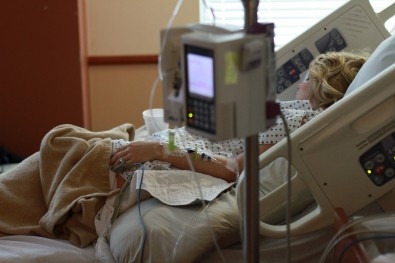

In Brazil, researchers tracked 80 patients with moderate and severe forms of the disease for up to six months after they left hospital. Muscle impairment during hospitalization was also a predictor of higher healthcare costs in the ensuing months (photo: Parentingupstream/Pixabay)
In Brazil, researchers tracked 80 patients with moderate and severe forms of the disease for up to six months after they left hospital. Muscle impairment during hospitalization was also a predictor of higher healthcare costs in the ensuing months.
In Brazil, researchers tracked 80 patients with moderate and severe forms of the disease for up to six months after they left hospital. Muscle impairment during hospitalization was also a predictor of higher healthcare costs in the ensuing months.

In Brazil, researchers tracked 80 patients with moderate and severe forms of the disease for up to six months after they left hospital. Muscle impairment during hospitalization was also a predictor of higher healthcare costs in the ensuing months (photo: Parentingupstream/Pixabay)
By Maria Fernanda Ziegler | Agência FAPESP – The more muscle mass is lost during hospitalization for COVID-19, the greater the likelihood of developing persistent symptoms of the disease, such as weakness and so-called long COVID, which can include shortness of breath (dyspnea), persistent coughs and headaches, insomnia and anxiety.
This is the main finding of a study conducted at the University of São Paulo’s Medical School (FM-USP) in Brazil and reported in an article published in the Journal of the American Medical Directors Association.
The results also point to a probable correlation between loss of muscle mass and the cost of healthcare in the months following discharge from hospital. “Loss of muscle mass is reasonably common during long hospital stays, but this condition appears to be particularly severe among patients hospitalized for COVID, affecting muscle mass, strength and function so much that the patient’s mobility is impaired in some cases,” said Hamilton Roschel, last author of the article. Roschel is one of the coordinators of the Applied Physiology and Nutrition Research Group, comprising graduate students and scientists affiliated with FM-USP and the same university’s School of Physical Education (EEFE-USP).
Funded by FAPESP via two projects (17/13552-2 and 20/08091-9), the investigation involved 80 moderate and severe COVID-19 patients admitted in 2020, before any vaccines were available, to Hospital das Clínicas, the hospital complex run by FM-USP. The volunteers were followed during and after treatment in hospital.
The researchers measured muscle strength and mass on four occasions: hospital admission, discharge, and two and six months after discharge. Muscle strength was measured with a handgrip dynamometer. Grip correlates well with overall muscle strength in the literature. Muscle mass was assessed by ultrasound scan of the vastus lateralis cross-sectional area at the side of the thigh.
“Muscle function is often associated solely with locomotion, but the musculoskeletal system is much more complex than that. It participates in several other processes in the organism, such as regulation of the metabolism and even of the immune system,” Roschel explained.
The analysis performed six months after discharge showed that 76% of patients with high loss of muscle mass suffered from fatigue and 66% from myalgia (muscle pain), compared with 46% and 36% respectively for those with low muscle loss. Importantly, the authors note, the high muscle loss group did not fully recover muscle mass they lost in hospital, whereas the low muscle loss group did.
Prognosis predictor
The researchers also estimated the cost of healthcare for these patients during the six months after they were discharged from hospital. “Although there were no big differences in re-hospitalization and self-perceived health problems, the post-discharge COVID-related healthcare costs were much greater for the high muscle loss group,” Roschel said.
Healthcare costs for participants who suffered high muscle loss in the acute stage of the disease averaged USD 77,000 per patient two months after hospital discharge, compared with USD 3,000 for the low muscle loss group. Expenses incurred with rehabilitation and treatment of other complications six months after discharge averaged USD 90,000 for the high muscle loss group, compared with USD 12,000 for the low muscle loss group.
“The results show that loss of muscle mass appears to be a predictor of negative prognosis for hospitalized patients, which suggests that testing should be performed to help decide whether should they be subject to therapeutic intervention while still in hospital,” Roschel said. “In terms of collective public health, we showed that loss of muscle mass is associated with higher costs, which certainly impact and pressure the health services not only financially but also in terms of demand for rehabilitation for these patients.”
Previous research by the group showed that assessment of muscle strength and mass can help predict the length of hospital stays for treatment of COVID-19. When these parameters were measured on admission to hospital, patients with healthier muscles tended to need shorter hospital stays (read more at: agencia.fapesp.br/35783).
“That was the first stage of our research, showing how COVID-19 affects muscles and pointing to the importance of having a ‘prior muscle reserve’ to cope with the infection,” Roschel said. “This second study shows that six months after discharge, patients who lost more muscle mass not only failed to recoup the loss but also had more persistent symptoms and incurred higher healthcare costs. It’s important to note the impact of the disease on the musculoskeletal system and stress that health services need to keep monitoring muscle health after patients leave hospital and recover from the disease.”
The article “Acute muscle mass loss predicts long-term fatigue, myalgia, and health care costs in COVID-19 survivors” is at: www.sciencedirect.com/science/article/pii/S152586102200891X.
Republish
The Agency FAPESP licenses news via Creative Commons (CC-BY-NC-ND) so that they can be republished free of charge and in a simple way by other digital or printed vehicles. Agência FAPESP must be credited as the source of the content being republished and the name of the reporter (if any) must be attributed. Using the HMTL button below allows compliance with these rules, detailed in Digital Republishing Policy FAPESP.





